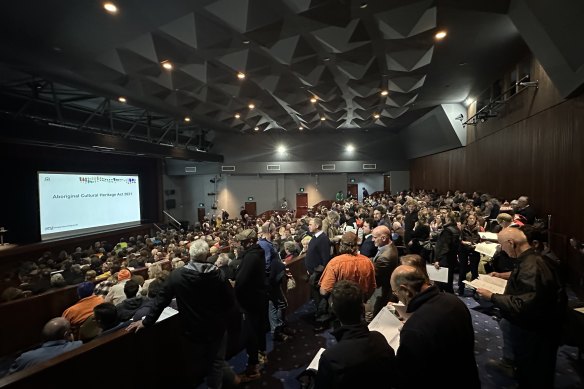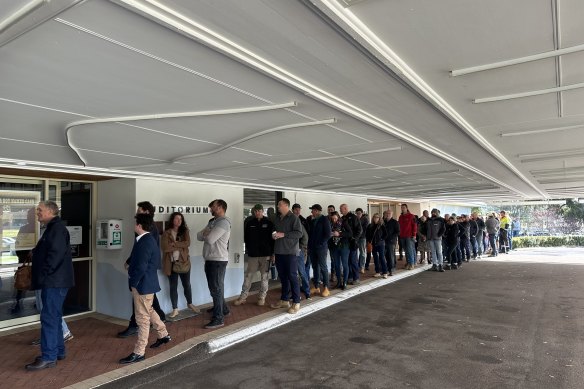A public servant running a three-hour education session on Western Australia’s new Aboriginal heritage rules was only able to get through five slides of a 45-slide presentation due to a barrage of questions from the 570 attendees.
The Department of Planning, Lands and Heritage-run event on Monday had to be delayed by half an hour to allow the huge line of locals to enter the Esperance Civic Centre’s auditorium, highlighting the deep confusion in WA’s agricultural regions over the new rules taking effect in just 16 days.

An Aboriginal Cultural Heritage Act education session in Esperance on Monday was attended by 570 people.Credit: WA Nationals/Facebook
The biggest confusion stems from requirements for landowners with properties larger than 1100 square metres to apply for permits or create management plans for work on their land that may impact an Aboriginal cultural heritage site.
The opposition and farming groups were concerned the systems were not in place to support the new rules and implored the Cook government to delay their implementation.
Esperance farmer Natalie Bowman attended Monday’s meeting and said many remained confused about what the laws could mean for them, particularly when it came to finding out whether an area could be an Aboriginal cultural heritage site.
“The general feeling in the room was that no one wants to deliberately harm Aboriginal cultural heritage, we all care about that, so help us figure out how to do what we need to do without harming it,” she said.
“It seems that they’re not able to tell us where [heritage sites are] because a lot of this country here hasn’t been surveyed yet, so we might now need to pay to have it surveyed to find out whether there is any [sites] or there isn’t.”
Bowman said farmers had not been consulted properly throughout the process.
“We are feeding a nation and this act, this legislation, has the potential to stop us from maybe doing that,” she said.
“It’s just going to make doing the things that we do a whole lot harder, I think and there’ll be a price tag attached to some of those things as well.”
The opposition claims the rules mean even landowners in metropolitan Perth who sit on blocks bigger than 0.11 hectares could be caught up in more red tape for simple changes to their property, such as installing a pool or a shed.

The session was delayed by half an hour as attendees streamed into the Esperance Civic Centre.Credit: WA Nationals/Facebook
Opposition Leader Shane Love wrote to Premier Roger Cook last week, calling on him to delay the rules by six months.
“The risk in implementation before the state is ready, is many West Australians are exposed to significant risk of penalty because they have not been afforded the opportunity to understand their responsibilities under Labor’s ACH Act,” he said.
A spokesman for Aboriginal Affairs Minister Tony Buti said the government still intended to proceed with the July 1 date.
He rubbished concerns that the agricultural sector would be negatively impacted, pointing to exemptions that would allow like-for-like activities already occurring on farms to continue going ahead without permits.
“For example, a farmer planting a crop, running livestock or replacing a fence or other existing infrastructure will be exempt and not require approval,” he said.
Buti said it was already unlawful under the 1972 laws to harm Aboriginal cultural heritage, but the new laws ensured there was more consultation with Aboriginal people.
When questioned about his government’s consultation process in parliament, Buti said the laws’ implementation had been a five-year process and more than 1000 people, including farmers, attended 90 workshops where the rules were developed.
Tensions boil over in parliament
In a heated exchange during question time that spilled over into a Matter of Public Interest on Tuesday, Labor labelled the opposition’s resistance to the rules as “dog whistling” – a term describing subtle public language used by politicians to garner support from certain communities.
During question time, Kimberley MP, Yawuru, Nimanburr and Bardi woman Divina D’Anna interjected in a government response, accusing the opposition of being “racist”.
Cook likened the resistance to the Court Liberal government’s opposition to federal native title laws in the early 1990s, and said it was like “a dog returning to its vomit”.
That led to Nationals MP Mia Davies blasting the government for suggesting the opposition was racist, saying all she was doing was trying to improve rules they voted for.
“I will not tolerate being told that we are dog whistling, or we are racist,” she said.
Davies said there was genuine community concern about how the rules would operate practically.
How the rules work
The new rules break down the impact of land changes into three tiers.
Tier one is work that has no ground disturbance and does not require a permit.
Tier two changes do require a work permit and cover land changes with minimal ground disturbance, like a farm road or fence.
Tier three covers major ground disturbances, which range from building a farm dam to digging a mine. This work requires a management plan developed with a local Aboriginal group.
Changes not near an Aboriginal cultural heritage site do not require a permit.
Landowners themselves can determine whether there is a site but risk penalties including jail if they fudge it or get it wrong.
The government is paying $10 million to establish local Aboriginal cultural heritage services that will be a one-stop-shop for permit and management plans, as well as help to determine what sites are of cultural significance in the absence of a heritage survey.
With the new rules just a fortnight away no services have officially been formed despite more than 20 applications.
Buti’s spokesman said the new laws did not rely on services being established and landowners could consult existing relevant native title bodies.
The Morning Edition newsletter is our guide to the day’s most important and interesting stories, analysis and insights. Sign up here.